The Alt-Az mount is gaining fame again after many years in the shadow of the polar aligned parallactic mount. The ever increasing possibilities within computer control has made it possible to design Alt-Az mounts capable of delivering precise equatorial tracking. Having the simple mechanical principles of the Alt-Az mount, these new mounts offer easier transport and faster setup than the typical polar aligned mount.
Setting up an Alt-Az telescope mount – no leveling needed
Basically, an Alt-Az mount has a vertical azimuth axle and a horizontal altitude axle. However, this does not need to be precise with many newer mounts where the software handles the alignment. Therefore, the great advantage setting up an Alt-Az mount is that no leveling of any kind is needed. Just set up the tripod or pier and install the mount head. No need for bubble levels or compass directions.
Balancing the mount – only one axle to worry about
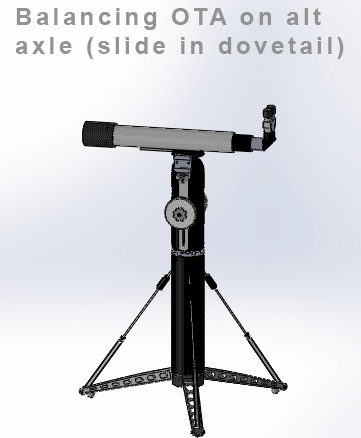
When you balance an Alt-Az mount, there is only one axle to worry about. The Azimuth axle is vertical and hence needs no balancing at all. The altitude axle is balanced by sliding the telescope OTA in the dovetail saddle or tube rings. A piggybacked guide scope must most times be balanced with a separate counterweight on the OTA – though some Alt-Az mounts have counterweights that can handle this too (as shown in animation).
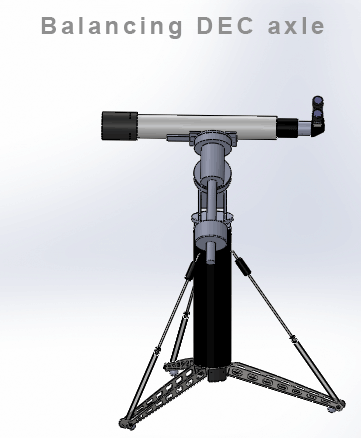
When you balance a polar aligned mount, there are two axles to worry about. Firstly, you balance the declination axle by sliding the telescope OTA in the dovetail saddle or tube rings. If a piggybacked guide telescope is installed on the main OTA, it is most times necessary to have a counterweight on the opposite side of the main OTA. Secondly, you balance the RA axis by adjusting the position of the counterweight.
Aligning the mount to track the sky – no more polar aligning
When the Alt-Az mount is setup and balanced, it can be sky aligned. For all available mounts, this is done by pointing the telescope at 1 to 3 known stars or planets. The way this is done in the hand controller can vary, but the basic function is the same: By measuring the position of the alignment stars, the mount software can calculate the precise setup angle and compensate for this to achieve precise goto and tracking, even though the mount was not leveled in any way.
This makes the Alt-Az mount so fast and easy to start up and alignment stars can be found in any direction making it unimportant if areas e.g. Polaris are covered by trees or buildings.
No more turning the telescope and eyepieces upside down
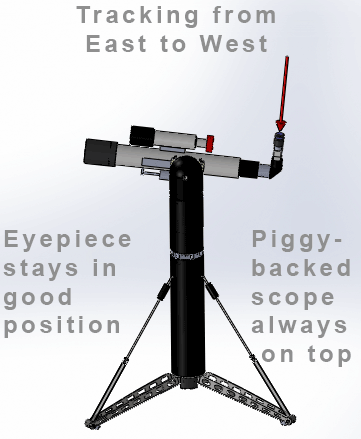
The movement pattern of the Alt-Az mount is very simple. Around the vertical Azimuth axle, the telescope can swing 360 degrees making it point in any compass direction. Around the altitude axle, the telescope can swing from horizontal up to vertical.
This simple movement pattern has the advantage, that the telescope OTA always stays in the same angle . If you insert an eyepiece in a diagonal, it will keep the same angle when the telescope moves around the sky. If your finder telescope is placed nicely on top of the main OTA, it will stay in that position.
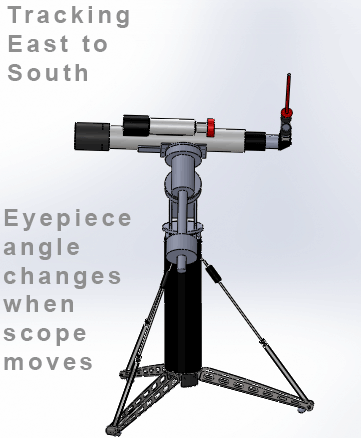
Compared to the polar aligned parallactic mount, this is quite different. Due to the fact that the polar axle is inclined, the telescope OTA will move in a pattern making the eyepiece and finder scope change positions so they are less comfortable to view in or sometimes impossible to view in without rotating them. On top of this, some Polar aligned mounts (German Equatorial Mounts) must perform a meridian flip when they pass south. This operation swings the telescope around so that everything placed on the top of the OTA suddenly is placed below the OTA. This is also a bad idea for the collimation of the telescope, as the mirror will lean towards the opposite side of the mirror cell.
Summing this up, it is clear that the basic movement pattern of an Alt-Az mount is better for the observer and the telescope.
Astrophotography with Alt-Az mounts – new possibilities
Almost everybody can agree that the Alt-Az mount has several advantages over the polar aligned parallactic mount as described above. It is very hard to see it differently.
When it comes to doing astrophotography, the situation is a bit different. An Alt-Az mount can track an object in the sky precisely, but the sky around the object tracked will over time rotate in the field of view. So using a basic Alt-Az mount (without rotator) for Astrophotography has some limitations.
But new technologies are changing the picture. New cameras with lower and lower read out noise are emerging. Therefore, short exposure astrophotography is giving better results and becomes more popular. The basic Alt-az mount is perfect for this kind of astrophotography.
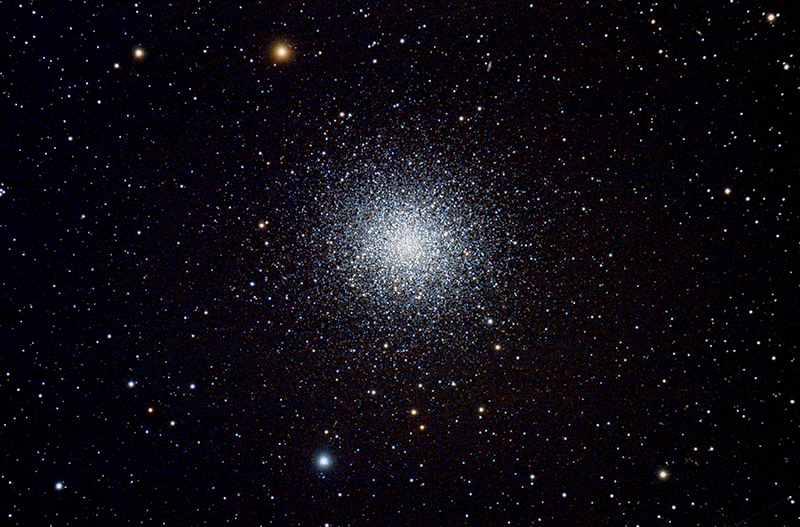
For many faint objects, long exposure subs are still needed. Again, the technology is giving new possibilities. By adding rotator systems – either rotating the main OTA or just the camera – to high quality Alt-Az mounts, long exposure subs are easily available. And all the earlier mentioned advantages of the Alt-Az mount are kept. Remember that all the big Pro telescopes work this way.
In the next article, I will look more into the Astrophoto possibilities with Alt-Az mounts. Stay tuned.